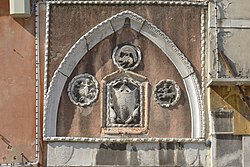Patera (architecture)

In architecture, patera (pl. paterae) is an ornamental circular or elliptical bas-relief disc.[1][2] The patera is usually used to decorate friezes and walls, and to interrupt moldings.[3] Patera is also used in furniture-making. It can be carved, incised, inlaid, or even painted.[4][5]
Overview
The patera is found in the ancient Roman architecture and in almost all later western styles of architecture.[6] The patera is used both within the civil and church architecture is usually made of marble or Istrian stone. It has a variable diameter between 20 and 80 cm, while the thickness is around 10 cm. The subject represented in the bas-relief is generally of floral or animal type, but there are also figures symbolizing trades or people.[7] Being mainly a decorative element, the patera may also perform an apotropaic function to keep away evil spirits.
Gallery
- Patera in the Corte seconda del Milion court and the romanesque archway Sotoportego del Teatro in Venice.
- Detail of the church Santa Margherita in Venice.
- Lunette above the entrance to the Fondaco dei Turchi reconstructed in neobyzantine stile by Federico Berchet AD 1869 in Venice.
- Entrance to the Carmini church in Venice.
- Volto Santo on the Strada Nuova in Cannaregio Venice.
References
- ^ "Fragment of Roman frieze(?) enrichment: a patera with a floral centre". CollectionsOnline. Retrieved 3 September 2019.
- ^ Saylor, Henry H. (1994). Dictionary of Architecture. John Wiley & Sons. p. 128. ISBN 9780471756019. Retrieved 3 September 2019.
- ^ Parker, John Henry (1845). A Glossary of Terms Used in Grecian, Roman, Italian, and Gothic Architecture. J.H. Parker. p. 274. Retrieved 3 September 2019.
patera architecture.
- ^ Furniture, Mackinnon Fine (6 August 2019). "The ABCs of Decorative Arts: Patera". The Source. Retrieved 3 September 2019.
- ^ "Patera and Paterae". Lynn Byrne. 28 May 2013. Retrieved 3 September 2019.
- ^ "Patera". Buffalo as an Architectural Museum. buffaloah.com. Retrieved 3 September 2019.
- ^ Scott, Ann Reynolds (2008). Cosa: The Black-glaze Pottery 2. University of Michigan Press. p. 62. ISBN 9780472115853. Retrieved 3 September 2019.





